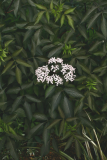Additional notes (click to expand)
Medicinal
The following notes refer to the uses of the species of this plant in traditional medicine.
S. nigra is considered anti-inflammatory; aperient; diaphoretic; diuretic; emetic; emollient; expectorant; galactogogue; haemostatic; laxative; ophthalmic; purgative; salve and stimulant.
Nomenclature
Previously grown as Sambucus nigra f. porphyrophylla 'Gerda'
Plants of the World online, Kew Science http://plantsoftheworldonline.org/?q=Sambucus%20nigra%20f.%20porphyrophylla
link
Other use
The leaves, stems and seeds contain cyanogenic glycosides which liberate hydrogen cyanide when crushed or chewed. While elderberry cordials are drunk widely, it has not been accepted for use as a traditional herbal medicine (European Medicines Agency, draft report, 2013)
Note see also Toxicity under Sambucus nigra
Oakeley, Dr. Henry F. (2013). Wellcome Library notes.
link
Toxicity
The leaves, stems and seeds contain cyanogenic glycosides which liberate hydrogen cyanide when crushed or chewed.
Oakeley, Dr. Henry F. (2013). Wellcome Library notes
Sambucus nigra L. 'Gerda'
Family: VIBURNACEAEGenus: Sambucus
Species: nigra L.
Cultivar: 'Gerda'
Distribution summary: Eurasia, N.&S. America
Habit: Shrub
Hardiness: H5 - Hardy; cold winter
Habitat: Deciduous woods, scrub, hedgerows, calcareous woods
Garden status: Currently grown
Garden location: Plants of the World (B)
Reason for growing: Medicinal, other use, toxic, traditional herbal registration


